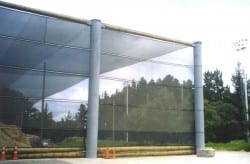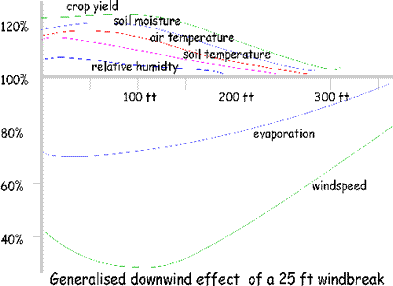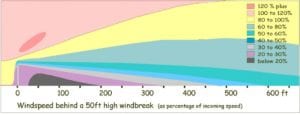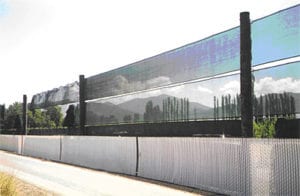WHY HAVE A WIND SHELTER / WIND FENCE
Wind causes erosion, transports dust, spray, and other pollution. Wind also restricts plant growth, damages plants and buildings, and reduces efficiency of heating systems.
Windbreaks or wind shelters are used in agriculture for two distinct types of reasons. The first is the obvious macro-effect of reducing the power of the wind which in turn reduces the mechanical fruit or tree damage. Note that this type of damage is caused by windpower. Windpower = windspeed x windspeed.
So, when windspeed is 1/4, windpower is 1/4 x 1/4 = 1/16
Windpower is what you feel when you try and stand up in a strong wind. Clearly, even a small reduction in windspeed is enough to cause a dramatic reduction in windpower.
Wind power is also responsible for erosion and for transport of spray and dust.

The second type of benefit for wind shelters are the improvement in the micro-climate within the grid. This is the actual growing environment. It includes things such as temperature, evapotranspiration and humidity. Wind is another micro-effect that is often over-looked. When a plant is moved photosynthesis shuts down and the plant stops growing. The length of time depends on the plant and the violence of the movement. With grapes for example, a gust of wind of a few miles per hour is enough to stop growth for several minutes after the gust has passed. The effect of these micro-climate type effects is summarized in the graph below.
GENERAL INFORMATION ON WIND SHELTER
WHAT DOES A WINDBREAK DO?
A windbreak slows the wind in one place by deflecting it to another. The best windbreaks produce a zone behind the windbreak which will have wind of about a quarter of the speed. For a 50ft (15.24m) high windbreak this zone will extend about 250ft (76m) downwind. From 250ft (76m) to 500ft (152m) the windspeed will increase up to about half that of the incoming wind. Beyond that windspeeds increase quickly.
[NOTE the terms windbreak, windfence, wind shelter, shelter fence, and wind screen are used interchangeably here. Purists might see a windbreak as a row (or several rows close together) of trees, yet a fabric or artificial shelter achieves the same thing, so it is easiest to use windbreak as the general term.]
THE WIND
The wind is like a river, with the earth equivalent to the bottom of the river. Water flows and tumbles over the river bottom. The faster the flow, the more tumbling (turbulence).
If we were to throw a large rock into the river, we would create a sheltered spot immediately behind the rock. This is a windbreak in its most basic form. The problem is that just past the rock, the water that had been deflected over and around the rock would come crashing down and in.

WINDBREAKS
Windbreaks control the amount of “crashing down and in” by letting a little wind flow through. The wind flowing through holds the faster (deflected) wind away for a few hundred feet. This lets the winds merge together again more gently with less turbulence. The effects are shown in the drawing which shows a side view of a well-designed windbreak and the wind speeds around it.

WINDBREAK GRIDS
The Ultra Span windbreak grid system is designed to give excellent wind protection at a reasonable price. The windbreak is both aerodynamically and structurally very efficient.
HOW DOES IT WORK?
The grid has a gently sloping perimeter which deflects nearly all the wind upwards and lets a little wind through. To keep the wind up, a series of “baffles” are positioned at about every 100 ft (30.4 m) to bounce the wind up again. This is illustrated diagrammatically on the drawing below. The bounce effect is helped by the little wind that is let through, as it stops low pressure spots forming which would suck the wind back down.
WHAT MAKES IT AERODYNAMICALLY EFFICIENT?
For most parts of the world, the prevailing wind direction accounts for 1/4 to 1/2 of the wind. This highlights the importance of having shelter from all four directions. The grid does this. One of the secrets of efficient shelter is having an inclined upwind fence. The incline creates a longer flatter wind “shadow” with less turbulence and disruption of the high speed winds higher in the atmosphere.
WHAT MAKES IT STRUCTURALLY EFFICIENT?
The windbreak is a grid of cables with poles at the intersection points. Fabric panels are attached to the grid in the manner described below. When the wind blows from say the North, all the East-West cables hold the fabric panels across the wind. The North-South cables are supporting the poles. When the wind blows from the West the roles are reversed. This double duty creates the structural efficiency.
Grid protection system for Carembolas in South Florida. The grid is approximately 100 ft (30.4 m) square. Fences are 20 ft high with 10 ft access underneath. Note the ramped exterior for added shelter efficiency.
WINDBREAK CANOPIES
Canopies primarily designed for other purposes such as:
- shade
- hail protection
- bird exclusion
- temperature control
- humidity control
can provide very good wind shelter. The mesh size to generate good shelter depends on the shape of the structure and the turbulence of the incoming winds.
Your WeatherSolve designer will discuss fabric options and effectiveness with you.
WALKWAY SCREEN
This screen system can be adapted to any requirement. On one set of posts there is wind protection, a visual screen and a security fence. The posts in the photo are about 60ft (20m) apart which gives a number of advantages:
- Disruption to the site is minimized
- Less visual impact
- More economical (fewer, stronger poles are almost always more economical)
- Option of spanning across gullies, streams etc.

Walkway screen / security fencing – walk way screening Oregon
Alternative combinations of cladding, post heights and post spacing are available to meet your specific requirements.
The photo shows a fence screening at a public walkway from agricultural operations in Medford, OR. The upper part of the fence is to provide wind shelter for the orchard as well as reduce spray drift from the orchard.
The lower part has security mesh and slats installed on the same poles (Fence 20ft high, Poles at approx 45ft spacings)
